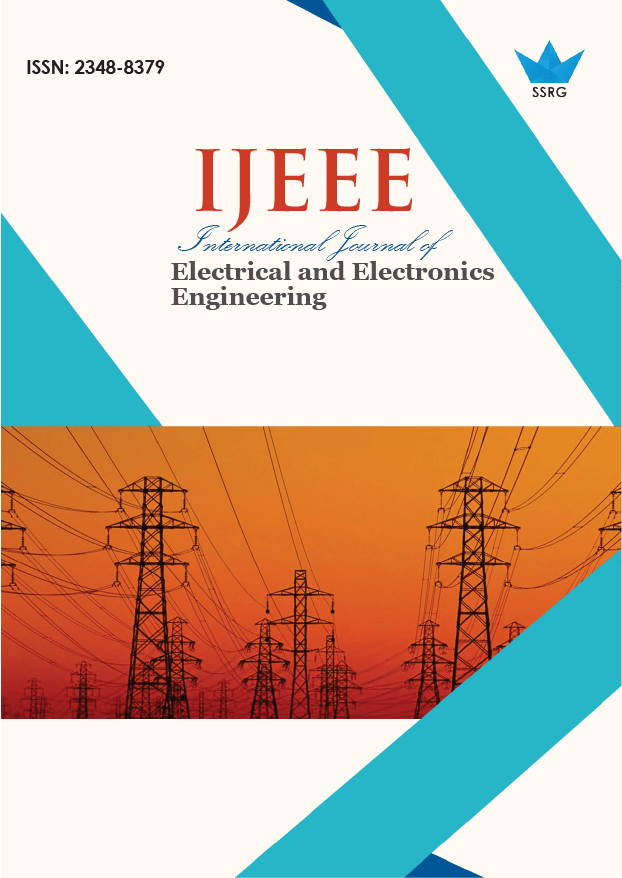Prediction of Available Transfer Capability with the Penetration of DG using ANN Techniques

| International Journal of Electrical and Electronics Engineering |
| © 2025 by SSRG - IJEEE Journal |
| Volume 12 Issue 8 |
| Year of Publication : 2025 |
| Authors : Manjula S Sureban, S.G. Ankaliki |
How to Cite?
Manjula S Sureban, S.G. Ankaliki, "Prediction of Available Transfer Capability with the Penetration of DG using ANN Techniques," SSRG International Journal of Electrical and Electronics Engineering, vol. 12, no. 8, pp. 287-294, 2025. Crossref, https://doi.org/10.14445/23488379/IJEEE-V12I8P125
Abstract:
The modern power system is subject to transformation from centralized to a distributed one because of the rapid advancements in Distributed Generation (DG) technology. At the same time, the increased demand for electricity is resulting in transmission network congestion, and the transmission lines are pushed to operate closer to their limit. This raises a need for power system operators to evaluate and enhance the Available Transfer Capability (ATC) of existing transmission lines to relieve the congestion in transmission networks and improve the power system reliability and security. Several methods, viz. Sensitivity factors-based methods and repeated power flow methods are used to estimate ATC by performing power flow studies. This paper demonstrates the development of Artificial Neural Networks (ANN) to predict the day ahead ATC of power system with the penetration of DGs by using its past performance.
Keywords:
PTDF method, ANN, Solar SG, Regression, Loss sensitivity factor.
References:
[1] Annoy, Available Transfer Capability Definitions and Determination, A Framework for Determining Available Transfer Capabilities of the Interconnected Transmission Networks for a Commercially Viable Electricity Market, North American Electric Reliability Council, 1996. [Online]. Available: https://www.ece.iit.edu/~flueck/ece562/atcfinal.pdf
[2] Olatunji Obalowu Mohammed et al., “Available Transfer Capability Calculation Methods: A Comprehensive Review,” International Transactions on Electrical Energy Systems, vol. 29, no. 6, pp. 1-24, 2019.
[CrossRef] [Google Scholar] [Publisher Link]
[3] G.C. Ejebe et al., “Fast Calculation of Linear Available Transfer Capability,” Proceedings of the 21st International Conference on Power Industry Computer Applications. Connecting Utilities. PICA 99. To the Millennium and Beyond (Cat. No.99CH36351), Santa Clara, CA, USA, vol. 15, no. 3, pp. 1112-1116, 2000.
[CrossRef] [Google Scholar] [Publisher Link]
[4] Romil Chauhan et al., “A Streamlined and Enhanced Iterative Method for Analyzing Power System Available Transfer Capability and Security,” Electric Power Systems Research, vol. 223, 2023.
[CrossRef] [Google Scholar] [Publisher Link]
[5] A.P. Sakis Meliopoulos, Sun Wook Kang, and George J. Cokkinides, “Probabilistic Transfer Capability Assessment in a Deregulated Environment,” Proceedings of the 33rd Annual Hawaii International Conference on System Sciences, Maui, HI, USA, vol. 1, 2000.
[CrossRef] [Google Scholar] [Publisher Link]
[6] X. Luo, A.D. Patton, and C. Singh, “Real Power Transfer Capability Calculations using Multi-Layer Feed-Forward Neural Networks,” IEEE Transactions on Power Systems, vol. 15, no. 2, pp. 903-908, 2000.
[CrossRef] [Google Scholar] [Publisher Link]
[7] Babatunde. O. Adewolu, and Akshay Kumar Saha, “Available Transfer Capability Enhancement with FACTS: Perspective of Performance Comparison,” 2020 International SAUPEC/RobMech/PRASA Conference, Cape Town, South Africa, pp. 1-6, 2020.
[CrossRef] [Google Scholar] [Publisher Link]
[8] Anurag Gautam et al., “Available Transfer Capability Enhancement in Deregulated Power System through TLBO Optimised TCSC,” Energies, vol. 15, no. 12, pp. 1-16, 2022.
[CrossRef] [Google Scholar] [Publisher Link]
[9] Akanksha Sharma, and Sanjay K. Jain, “Gravitational Search Assisted Algorithm for TCSC Placement for Congestion Control in Deregulated Power System,” Electric Power Systems Research, vol. 174, pp. 1-13, 2019.
[CrossRef] [Google Scholar] [Publisher Link]
[10] Ravi Kumar Poluru, and R. Lokesh Kumar, “Enhancement of ATC by Optimizing Tcsc Configuration using Adaptive Moth Flame Optimization Algorithm,” Journal of Computational Mechanics, Power System and Control, vol. 2, no. 3, pp. 1-9, 2019.
[CrossRef] [Google Scholar] [Publisher Link]
[11] Amit Kumar Singh, and Cuneyt Suheyl Ozveren, “A Novel Application of Sensitivity Factor (Ptdf) for Transmission Pricing Evaluation in a Deregulated Power Market,” Gazi University Journal of Science, vol. 33, no. 1, pp. 45-60, 2020.
[Google Scholar] [Publisher Link]
[12] Kevin Gurney, An Introduction to Neural Networks, 1st ed, CRC Press,1997.
[CrossRef] [Google Scholar] [Publisher Link]
[13] M Karuppasamy Pandiyan et al, “Online Estimation of Control Parameters of FACTS Devices for ATC Enhancement using Artificial Neural Network,” IOP Conference Series: Materials Science and Engineering, vol. 1055, no. 1, pp. 1-14, 2021.
[CrossRef] [Google Scholar] [Publisher Link]
[14] Naoki Marumo, Takayuki Okuno, and Akiko Takeda, “Majorization-Minimization-Based Levenberg-Marquardt Method for Constrained Nonlinear Least Squares,” Computational Optimization and Applications, vol. 84, no. 3, pp. 833-874, 2023.
[CrossRef] [Google Scholar] [Publisher Link]
[15] Abdullah M. Noman et al., “Scaled Conjugate Gradient Artificial Neural Network-Based Ripple Current Correlation MPPT Algorithms for PV System,” International Journal of Photoenergy, vol. 2023, pp. 1-8, 2023.
[CrossRef] [Google Scholar] [Publisher Link]
[16] Raimon O. Bawazir, and Numan S. Cetin, “Comprehensive Overview of Optimizing PV-DG Allocation in Power System and Solar Energy Resource Potential Assessments,” Energy Reports, vol. 6, pp. 173-208, 2020.
[CrossRef] [Google Scholar] [Publisher Link]

 10.14445/23488379/IJEEE-V12I8P125
10.14445/23488379/IJEEE-V12I8P125